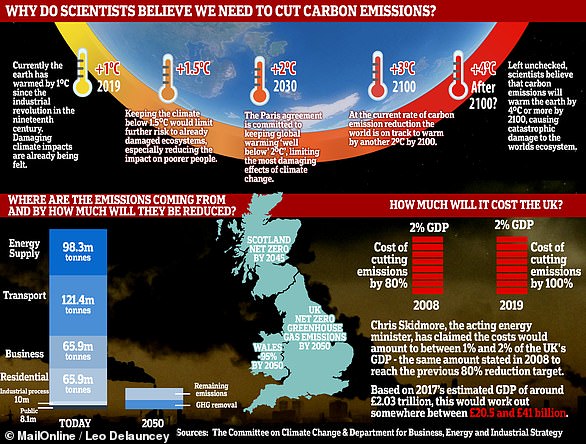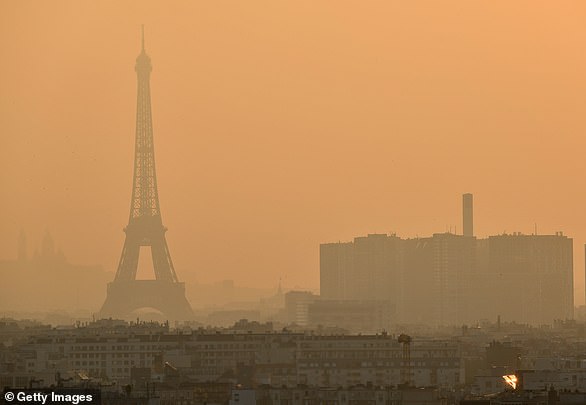Bizarre weather phenomenon in the form of ‘cloud glaciation’ could explain why people living near factories are likely to see SNOW this winter
Emissions
Carbon dioxide
Carbon dioxide (CO2) is one of the biggest causes of global warming. After the gas is released into the atmosphere, it remains there, making it difficult for the heat to escape – and warming the planet in the process.
It is mainly released during the combustion of fossil fuels such as coal, oil and gas, and during the production of cement.
The average monthly concentration of CO2 in Earth’s atmosphere, as of April 2019, is 413 parts per million (ppm). Before the Industrial Revolution, the concentration was only 280 ppm.
CO2 concentrations have fluctuated between 180 and 280 ppm over the past 800,000 years, but have accelerated dramatically due to human-induced pollution.
Nitrogen dioxide
The gas nitrogen dioxide (NO2) comes from the combustion of fossil fuels, car exhaust emissions and the use of nitrogen fertilizers used in agriculture.
Although there is much less NO2 in the atmosphere than CO2, it is between 200 and 300 times more effective at trapping heat.
Sulfur dioxide
Sulfur dioxide (SO2) also comes mainly from the combustion of fossil fuels, but can also be released from car exhaust.
SO2 can react with water, oxygen and other chemicals in the atmosphere and cause acid rain.
Carbon monoxide
Carbon monoxide (CO) is an indirect greenhouse gas because it reacts with and removes hydroxyl radicals. Hydroxyl radicals shorten the life of carbon dioxide and other greenhouse gases.
Particles
What is particulate matter?
Particulate matter refers to small particles of solid or liquid materials in the air.
Some are visible, like dust, while others cannot be seen with the naked eye.
Materials such as metals, microplastics, soil and chemicals can be contained in particulate matter.
Particulate matter (or PM) is described in micrometers. The two main ones mentioned in reports and studies are PM10 (less than 10 micrometers) and PM2.5 (less than 2.5 micrometers).
Air pollution comes from the combustion of fossil fuels, cars, cement production and agriculture
Scientists measure the amount of particles in the air per cubic meter.
Particulate matter is released into the air by a number of processes, including burning fossil fuels, driving cars and making steel.
Why are particulate matter dangerous?
Particles are dangerous because particles with a diameter of less than 10 micrometers can penetrate deep into your lungs or even enter your bloodstream. Particulate matter is found in higher concentrations in urban areas, especially along main roads.
Impact on health
What health problems can pollution cause?
According to the World Health Organization, a third of deaths from stroke, lung cancer and heart disease can be linked to air pollution.
Some of the effects of air pollution on the body are not yet clear, but pollution can worsen inflammation, causing blood vessels to narrow, leading to heart attacks or strokes.
In addition, almost one in ten cases of lung cancer in the UK is caused by air pollution.
Particles end up in the lungs and remain there, causing inflammation and damage. In addition, some chemicals in particles that enter the body can cause cancer.
Deaths due to pollution
About seven million people die prematurely every year due to air pollution. Pollution can cause a number of problems, including asthma attacks, strokes, various forms of cancer and cardiovascular problems.

Asthma triggers
Air pollution can cause problems for asthmatics for several reasons. Pollutants in traffic fumes can irritate the airways, and particles can enter your lungs and throat and inflame these areas.
Problems during pregnancy
Women exposed to air pollution before pregnancy are almost 20 percent more likely to have babies with birth defects, research found in January 2018.
If you live within 3 miles of a highly polluted area for a month before you become pregnant, women are more likely to have a child with abnormalities such as cleft palate or lips, according to a University of Cincinnati study.
For every 0.01 mg/m3 increase in fine air particles, birth defects increase by 19 percent, the study found.
Previous research shows that this causes birth defects due to women suffering from inflammation and ‘internal stress’.
What is being done to tackle air pollution?
Paris Agreement on Climate Change
The Paris Agreement, first signed in 2015, is an international agreement to control and limit climate change.
It hopes to keep the increase in global average temperatures below 2°C (3.6°F) “and work to limit the temperature increase to 1.5°C (2.7°F).”
Carbon neutral by 2050
The British government has announced plans to make the country climate neutral by 2050.
They plan to do this by planting more trees and installing carbon capture technology at the source of the pollution.
Some critics worry that the government will use this first option to export its carbon offsets to other countries.
International carbon credits allow countries to continue emitting carbon while paying to plant trees elsewhere, offsetting their emissions.
No new petrol or diesel vehicles in 2040
In 2017, the British government announced that the sale of new petrol and diesel cars would be banned by 2040.
However, MPs on the climate change committee have urged the government to bring forward the ban to 2030, saying they will have equivalent reach and price by then.

The Paris Agreement, first signed in 2015, is an international agreement to control and limit climate change. In the photo: air pollution above Paris in 2019.
Norwegian subsidies for electric cars
The rapid electrification of Norway’s car fleet is mainly attributed to generous state subsidies. Electric cars are almost completely exempt from the heavy taxes on petrol and diesel cars, making them competitively priced.
A VW Golf with a standard combustion engine costs almost 334,000 crowns (34,500 euros), while its electric cousin, the e-Golf, costs 326,000 crowns thanks to a lower tax quotient.
Criticism of inaction on climate change
The Committee on Climate Change (CCC) has said there has been a ‘shocking’ lack of government preparedness for the risks to the country from climate change.
The committee assessed 33 areas where climate change risks needed to be addressed – from the resilience of properties to flooding to the impact on agricultural land and supply chains – and found no real progress in any of these areas.
Britain is not prepared for 2°C of warming, the level at which countries have pledged to curb temperature rise, let alone a 4°C rise that is possible if global greenhouse gases are not reduced, the commission says .
It added that cities need more green spaces to stop the urban ‘heat island’ effect and prevent flooding by absorbing heavy rainfall.
